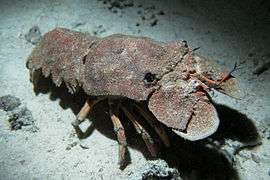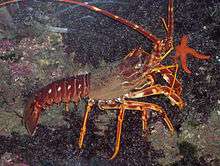Cancrinos
Cancrinos is a genus of fossil crustacean closely allied with the slipper lobsters. One species is known, C. claviger from the Jurassic of southern Germany.
| Cancrinos | |
|---|---|
| Scientific classification | |
| Kingdom: | |
| Phylum: | |
| Subphylum: | |
| Class: | |
| Order: | |
| Infraorder: | |
| Family: | †Cancrinidae Beurlen, 1930 |
| Genus: | †Cancrinos Münster, 1839 |
| Type species | |
| †Cancrinos claviger Münster, 1839 | |
| Species | |
| |
Taxonomy
Fossils of Cancrinos are rare, and their state of preservation is often imperfect.[1] Count Georg zu Münster first described Cancrinos in 1839, based on material from the Upper Jurassic Solnhofen limestones of southern Germany.[2] He described two species, Cancrinos claviger and C. latipes, differentiated by the size of the second antennae,[2] but the two are now considered to be synonyms.[1]
Further specimens have been discovered in Upper Cretaceous lithographic limestones of Lebanon, and described as a new species, C. libanensis;[3] however, Haug et al. (2016) made it the type species of a separate genus Paracancrinos.[4]
Classification
Although Münster was unable to discern any living relatives of Cancrinos during his original description,[2] Reinhard Förster proposed in 1984 that Cancrinos was a transitional form between spiny lobsters (Palinuridae) and slipper lobsters (Scyllaridae).[5][6]
Description


Cancrinos differs most markedly from other related animals by the form of the second antennae, which are flattened towards the end, approaching the state seen in living slipper lobsters.[7] Unlike living slipper lobsters, however, the flattened, distal parts of the antennae retain the ancestral state of comprising many segments, rather than being reduced to a single element.[7]
Development
Because immature specimens have been found, parts of the ontogeny of Cancrinos are known, although it is unclear whether the smallest specimens are in the puerulus stage, or are juveniles.[1] Younger specimens have less flattened antennae, more like those of living spiny lobsters; thus, Canrcinos exhibits a form of heterochrony known as peramorphosis.[7] This ontogeny is thought to reflect the phylogeny of Cancrinos, representing a partial development from the ancestral spiny lobster-like form towards the derived slipper lobster-like form.[7]
References
- Joachim T. Haug; Carolin Haug; Dieter Waloszed; Andreas Maas; Matthias Wulf; Günter Schweigert (2009). "Development in Mesozoic scyllarids and implications for the evolution of Achelata (Reptantia, Decapoda, Crustacea)" (PDF). Palaeodiversity. 2: 97–110.
- Georg zu Münster (1839). "Cancrinos". Decapoda Macroura. Abbildung und Beschreibung der fossilen langschwänzigen Krebse in den Kalkschiefern von Baiern. Beiträge zur Petrefacten-Kunde. 2. Bayreuth, Germany. pp. 43–45.
- Alessandro Garassino; Günter Schweigert (2006). "The Upper Jurassic Solnhofen decapod crustacean fauna: review of the types from old descriptions. Part I. Infraorders Astacidea, Thalassinidea, and Palinura". Memorie della Società Italiana di Scienze Naturali e del Museo Civico di Storia Naturale di Milano. 34.
- Joachim T. Haug; Denis Audo; Sylvain Charbonnier; Ferran Palero; Gilles Petit; Pierre Abi Saad; Carolin Haug (2016). "The evolution of a key character, or how to evolve a slipper lobster" (PDF). Arthropod Structure & Development. 45 (2): 97–107. doi:10.1016/j.asd.2015.08.003. PMID 26319267.
- Carolin Haug; Joachim T. Haug; Dieter Waloszek (2009). "Neues zur Krebsfauna der süddeutschen Plattenkalke" [Developments in the crustaceans of the plattenkalks of southern Germany] (PDF). Archaeopteryx (in German). 27: 31–37. Archived from the original (PDF) on 2016-03-03. Retrieved 2012-02-05.
- Reinhard Förster (1984). "Bärenkrebse (Crustacea, Decapoda) aus dem Cenoman des Libanon und dem Eozän Italiens". Mitteilungen der Bayerischen Staatssammlung für Paläontologie und historische Geologie. 24: 57–66.
- Joachim T. Haug; Carolin Haug; Dieter Waloszek; Günter Schweigert (2011). "The importance of lithographic limestones for revealing ontogenies in fossil crustaceans" (PDF). Swiss Journal of Geoscience. 104 (Suppl. 1): S85–S98. doi:10.1007/s00015-010-0033-1. Archived from the original (PDF) on 2016-06-30. Retrieved 2012-02-05.
External links
